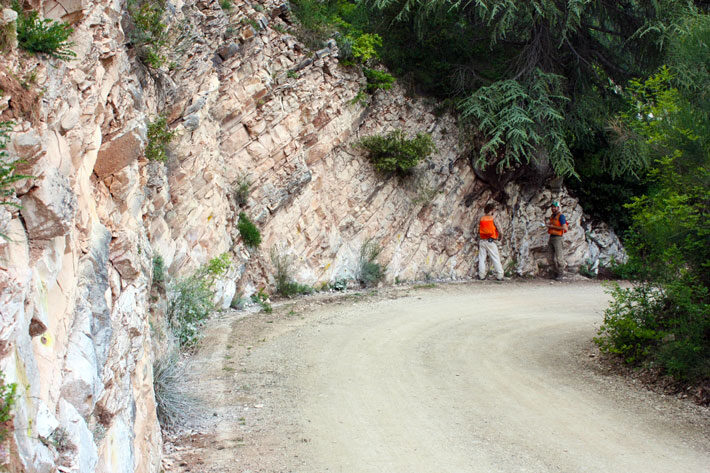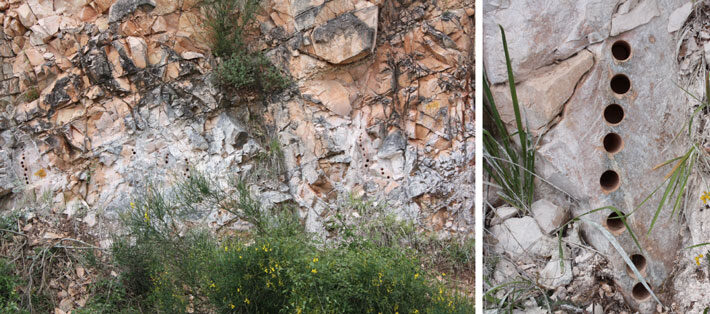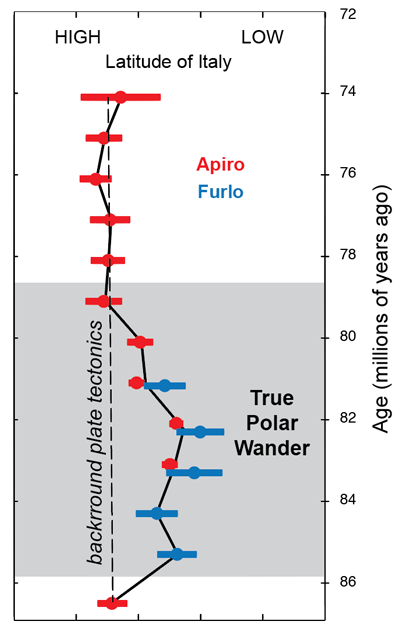
Scaglia Rossa Limestone exposed near Furlo, Italy, in the Northern Apennine Mountains. Limestone at this locality accumulated on the bottom of a shallow sea, in an arm of the ancient Mediterranean ocean nearly 85 million years ago, during what is called Late Cretaceous time.
Despite this wandering of the crust, Earth' magnetic field is generated by electrical currents in the convecting liquid Ni-Fe metal of the outer core. On long time scales, the overlying wander of the mantle and crust does not affect the core, because those overlying rock layers are transparent to Earth's magnetic field. In contrast, the convection patterns in this outer core are actually forced to dance around Earth's rotation axis, which means that the overall pattern of Earth's magnetic field is predictable, spreading out in the same fashion as iron filings lining up over a small bar magnet. Hence, these data provide excellent information about the direction of the North and South geographic poles, and the tilt gives the distance from the poles (a vertical field means you are at the pole, horizontal tells us it was on the Equator). Many rocks actually record the direction of the local magnetic field as they form, in much the same way that a magnetic tape records your music. For example, tiny crystals of the mineral magnetite produced by some bacteria actually line up like tiny compass needles, and get trapped in the sediments when the rock solidifies. This, "fossil" magnetism can be used to track where the spin axis is wandering relative to the crust.
"Imagine looking at Earth from space," explains Kirschvink "True polar wander would look like the Earth tipping on its side, and what's actually happening is that the whole rocky shell of the planet — the solid mantle and crust — is rotating around the liquid outer core." Although scientists can measure true polar wander occurring today very precisely with satellites, geologists still debate whether large rotations of the mantle and crust have occurred in Earth's past.

High-resolution sampling on the road cut west of the Apiro Dam lake, in the Central Apennine Mountains of Italy.
This particular locality crosses the boundary of a major geomagnetic reversal, known as the Chron 33R / 33N transition, dated close to 80 million years ago. An amazingly high fraction of oriented samples from these localities yields superb records of the ancient magnetic field at the time they formed.
Mitchell and Kirschvink came up with a plan for settling the debate once and for all. Leveraging Mitchell's experience as a student studying the geology of the Apennine Mountains of central Italy, he knew just the right rocks to sample. The international team of researchers then placed their bet that paleomagnetic data from limestones created in the Cretaceous (between ~145.5 and 65.5 million years ago) located in Italy would provide a definitive test. The magnetism of the younger rocks in the same area was studied nearly 50 years ago, and indirectly led to the discovery of the asteroid impact that killed the dinosaurs. Sarah Slotznick, co-author and geobiologist at Dartmouth College explains, "these Italian sedimentary rocks turn out to be special and very reliable because the magnetic minerals are actually fossils of bacteria that formed chains of the mineral magnetite."
To test their hypothesis about true polar wander, paleomagnetic data with lots of redundancy are required to track the wander of the ancient location of Earth's spin axis. Prior studies, especially some claiming that true polar wander does not occur, have failed to explore enough data points according to the team. Says Richard Gordon, a geophysicist at Rice University in Houston who wasn't involved in the study, "that is one reason why it is so refreshing to see this study with its abundant and beautiful paleomagnetic data."

Latitude shift recorded in the Scalgia Rossa Limestone of the Italian Apennines. These data show that Italy took a brief excursion towards the Equator between 86 and 80 million years ago, coincident with a rotation observed from magnetic data collected from rocks from the seafloor of the Pacific Ocean.
Reference
Authors :Ross N. Mitchell1,2*, Christopher J. Thissen3, David A. D. Evans3, Sarah P. Slotznick4, Rodolfo Coccioni5, Toshitsugu Yamazaki6, Joseph L. Kirschvink2,7 Title of original paper :A Late Cretaceous true polar wander oscillation Journal :Nature Communications DOI :10.1038/s41467-021-23803-8
Affiliations :
1 State Key Laboratory of Lithospheric Evolution, Institute of Geology and Geophysics, Chinese Academy of Sciences, Beijing, China.
2 Division of Geological and Planetary Sciences, California Institute of Technology, Pasadena, CA, USA.
3 Department of Geology and Geophysics, Yale University, New Haven, CT, USA.
4 Department of Earth Sciences, Dartmouth College, Hanover, NH, USA.
5 Honorary Professor, Università di Urbino, Urbino, Italy.
6 Atmosphere and Ocean Research Institute, The University of Tokyo, Chiba, Japan.
7 Earth-Life Science Institute, Tokyo Institute of Technology, Tokyo, Japan.



Reader Comments
So that might mean that the astrological alignments are instigators, and the electrical flow is directed as per stellar and cosmic currents.
The major event, possible referenced to in this article, was when Earth was impacted with a small magnetic body which sank to the core splaying material outward to form the Moon.
Possibly Earth's own magnetoshpere had weakened, as geologic history shows, to the point of non existence allowing this electrically charged body to seek balance without the expected electrical storm when two charged bodies meet.